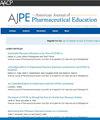Improving the Effectiveness of Workplace-based Assessment for Pharmacy Interns, An Evaluation Study
IF 3.8
4区 教育学
Q1 EDUCATION, SCIENTIFIC DISCIPLINES
引用次数: 0
Abstract
Objective
Growing interest in competency-based education has driven the need for reliable workplace-based assessment (WBA) tools to evaluate pharmacy graduate competency. Entrustable professional activities (EPAs), case-based discussion, and structured in-training assessment activities were introduced as part of an initial WBA “toolkit” for intern pharmacist training in Australia. The study aimed to explore perspectives on the impact of WBA tools—comprising EPAs, case-based discussion, and in-training assessment activities—on intern learning, feedback provision, intern-preceptor relationships, and workload.
Methods
Data were collected using 3 complementary approaches: (1) an anonymous cross-sectional survey of interns, pharmacist preceptors, and intern training program providers; (2) focus groups with pharmacy interns and/or pharmacist preceptors; and (3) structured interviews with pharmacists coordinating intern training. Qualitative data from focus groups and interviews were analyzed thematically, while survey data were analyzed using descriptive statistics.
Results
A total of 29 participants (interns: n = 13, pharmacists, n = 16) engaged across 9 focus groups. Ten pharmacists, equally distributed between community and hospital settings, were interviewed. A total of 510 individuals participated in the survey. Participants reported high satisfaction with the tools, highlighting 6 key themes: workplace learning, feedback, performance assessment, consistency in expectations, integration of reflective practices, and workload management. While these tools were well received and effectively used, managing the associated workload emerged as a challenge for interns and preceptors.
Conclusion
The integration of WBA tools into pharmacy intern training enhanced feedback quality and supported workplace learning and performance assessment. Although these tools increase workload for learners and supervisors, their benefits and overall value outweighed the challenges.
提高实习药师工作场所评价的有效性:一项评价研究。
背景:人们对能力本位教育的兴趣与日俱增,因此需要可靠的工作场所评估(WBA)工具来评估药学毕业生的能力。澳大利亚引入了委托专业活动(EPAs)、基于案例的讨论(CbD)和结构化培训评估活动(ITA-act),作为实习药剂师培训的初始WBA "工具包 "的一部分。目的:探讨由委托专业活动、基于案例的讨论和结构化培训评估活动组成的WBA工具对实习生学习、反馈提供、实习生与实习前指导者关系和工作量的影响:采用三种互补的方法收集数据:(1) 对实习生、药剂师指导员和实习生培训项目提供者进行匿名横断面调查;(2) 与药学实习生和/或药剂师指导员进行焦点小组讨论;(3) 与负责协调实习生培训的药剂师进行结构化访谈。对焦点小组和访谈的定性数据进行了主题分析,而对调查数据则使用描述性统计进行了分析:共有 29 人(实习生 13 人,药剂师 16 人)参加了 9 个焦点小组。10 名药剂师接受了访谈,社区和医院药剂师各占一半。共有 510 人参与了调查。参与者对这些工具的满意度很高,并强调了六个关键主题:工作场所学习、反馈、绩效评估、期望一致性、整合反思实践和工作量管理。虽然这些工具深受欢迎并得到了有效使用,但管理相关的工作量成为实习生和实习医生面临的一项挑战:将 WBA 工具整合到药学实习生培训中,提高了反馈质量,支持了工作场所学习和绩效评估。虽然这些工具增加了学员和督导人员的工作量,但其好处和价值超过了挑战。
本文章由计算机程序翻译,如有差异,请以英文原文为准。
求助全文
约1分钟内获得全文
求助全文
来源期刊
CiteScore
4.30
自引率
15.20%
发文量
114
期刊介绍:
The Journal accepts unsolicited manuscripts that have not been published and are not under consideration for publication elsewhere. The Journal only considers material related to pharmaceutical education for publication. Authors must prepare manuscripts to conform to the Journal style (Author Instructions). All manuscripts are subject to peer review and approval by the editor prior to acceptance for publication. Reviewers are assigned by the editor with the advice of the editorial board as needed. Manuscripts are submitted and processed online (Submit a Manuscript) using Editorial Manager, an online manuscript tracking system that facilitates communication between the editorial office, editor, associate editors, reviewers, and authors.
After a manuscript is accepted, it is scheduled for publication in an upcoming issue of the Journal. All manuscripts are formatted and copyedited, and returned to the author for review and approval of the changes. Approximately 2 weeks prior to publication, the author receives an electronic proof of the article for final review and approval. Authors are not assessed page charges for publication.

 求助内容:
求助内容: 应助结果提醒方式:
应助结果提醒方式:


